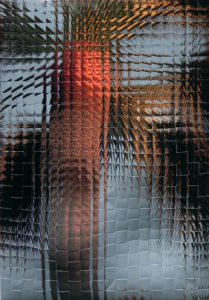
Reconstructed- Sights and Sounds of a Modern-day Weaver
Reconstructed- Sights and Sounds of a Modern-day Weaver
by Cris Worley
What inspires Dallas-based artist, Rusty Scruby, is only a fraction of his highly complex, engineering-based process of creating. “I want to see pattern the way we hear pattern in music,” says Scruby. A former student of both aerospace engineering and music composition, Scruby manifests these skills into his work, producing a sleek and intricate harmony of math and music.
Starting with a simple snapshot, Scruby makes thousands of identical inkjet prints. Based on the type of construction he wishes to create – a flat or undulating surface, a helix, he crops out and cuts certain images into precise “facets” which are engineered to interlock perfectly with one another. By interlocking these small pieces of paper, Scruby “weaves” the form much like one would weave knit fabric. This technique derives from a curious and longstanding-history of knitters in the artist’s family.
Pattern is the foundation of the work, both conceptually and visually. Initially, the viewer witnesses an orderly montage of a single image in replicate, each segment slightly varied from the one before. But the result is not straightforward, to say the least. With a little more time spent viewing these pieces, these patterns give way to a deeper understanding of the universal laws of science and mathematics. Like complexity theory, which studies the relationship between pattern and randomness, and like the combined frequencies of sound in music, Scruby’s mathematical inspirations seek to show the tension between the whole and the sum of its parts, between the original image and the constructed one.
While past works have revolved primarily around nostalgic childhood photographs, recent subject matter includes innocuous images of railroad crossings, traffic signs, meadows and fields of flowers. These quiet, even mundane themes burst into multifaceted, rhythmic schemes, creating haunting memories of the past and altered views of reality.
In the foreground of what would be a humble, urban landscape we see in Railroad Crossing, a large traffic sign deconstructed into several microcosmic components. While we recognize the sign to indicate a railroad crossing this visual schism does not reflect its true identity. Herein lies the essence of the work-the comparison between reality and that which comprises it. In this work, Scruby takes his concepts one step further. By weaving the surface into an undulating form he adds another instrument to his visual symphony, underpinning even more his ideas of “visual music” and sound waves.
Rusty Scruby recognizes the small, unseen parts of reality, which many of us do not even know exist. By bringing them to a visual realm he shows the viewer a new way of looking, even a new dimension.
